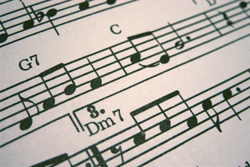 Common Chord Mnemonics
Common Chord Mnemonics
First, understand that chord nomenclature is a colloquialism of modern music, and there are occasional variances on how people use the symbols. I used the common forms below, which are a mixture of common pop music (such as the half-diminshed) and jazz influenced (such as minor major 7th) chord symbols. You will doubtless find people using the + symbol occasionally to mean "add" a specific note to a chord form (rather than augmented which is the more common form), and various other such renderings. In fact, the + is also sometimes used as a way to "sharp" a note in some circles. That said, I tend to revert to letters, instead of using symbols where possible, to avoid such confusion. Meaning, I would use C7aug rather than C7+ simply to avoid misunderstanding in some circles. Then again, if everyone simply used my chart below, there would be no confusion at all :). So there you go then- use this as gospel chord notation.
The use of "b" in this table symbolizes flat, and applies to the note that follows it in a chord form, or the chord name that proceeds it when contexted to the chord itself. The use of the "#" symbol indicates a sharp.
General chord theory has some "essentials" to remember:
- A basic chord is normally thought of as a triad (meaning 3) of notes. This means each simple chord is a combination of 3 distinct notes played simultaneously.
- Simple chords are named by the first note in their sequence. The first note in the chord sequence is also called the "root".
- The most basic form of a chord is a major chord. A major chord is the sequence of notes, beginning with the root as 1, moving up 2 positions to get the next note, and moving up two more positions to get the last note. The major chord includes notes in positions 1, 3 and 5 relative to the root.
| Form | Symbol | Alternate | 2nd Alt | Example | Example 2 | Notes | |
| Major | Δ | M | maj | C | Cmaj | 1 3 5 | |
| Minor | - | m | min | Cm | C- | 1 b3 5 | |
| Suspended | sus | sus4 | Csus | Csus4 | 1 4 5 | ||
| 2nd * | sus2 | sus9 | 2 | Csus2 | C2 | 1 2 5 | |
| 7 ** | 7 | dom7 | C7 | Cdom7 | 1 3 5 b7 | ||
| Minor 7 | -7 | m7 | min7 | Cm7 | C-7 | 1 b3 5 b7 | |
| Major 7 | Δ7 | M7 | maj7 | CΔ7 | Cmaj7 | 1 3 5 7 | |
| Diminished *** | ° | dim | dim7 | Cdim | C° | 1 b3 b5 bb7 or 1 b3 b5 6 | |
| Half Diminished | ø | m7-5 | m7(b5) | Cø | Cmin7(b5) | 1 b3 b5 b7 | |
| Augmented | + | aug | +5 | C+ | Caug | 1 3 #5 | |
| Augmented 7 | 7+ | aug7 | C7+ | 1 3 #5 b7 | |||
| Sixth | 6 | C6 | 1 3 5 6 | ||||
| Ninth | 9 | C9 | 1 3 5 b7 9 | ||||
| Minor 9th | m9 | min9 | Cm9 | Cmin9 | 1 b3 5 b7 9 | ||
| Major 9th | M9 | maj9 | Cmaj9 | CM9 | 1 3 5 7 9 | ||
| Diminished 9th | dim9 | Cdim9 | 1 3 5 b7 b9 | ||||
| Added 9 | add9 | (9) | Cadd9 | C(9) | 1 3 5 9 | ||
| Fifth | 5 | (no 3rd) | (no 3) | C5 | C(no 3) | 1 5 | |
| Eleventh | 11 | C11 | 1 3 5 b7 9 11 | ||||
| Minor major 7th | m M7 | mΔ7 | m maj7 | CmM7 | C-Δ7 | 1 b3 5 7 |
Notes:
* also called suspended 2nd
** also called dominant 7th
*** also called diminished 7th
Alternate Bass Chords
Sometimes called "slash chords", these are chords that follow all the same conventions as listed above, except that they add a single low note as the "bass" note in the chord. This simply means that in a chord such as "X/Y", that this is an "X chord with a Y in the bass". For example, you might see:
C/E
- this would simply be a C chord with an E note played in the bass. In this case you would play the regular C major chord and add the E note below the low C of your regular major C chord.
Figuring out chord names
Occasionally, you may find that you play a chord, but don't know how to name it. If you play guitar, there is a nice applet that can help you figure out the name of that chord. Go to the website, use this "Finder" to build the finger positions to find the chord name.
http://www.guitaristsreference.com/index.php?action=finder
